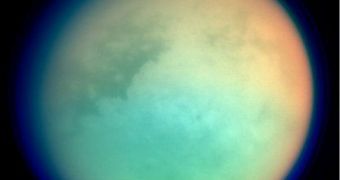According to the conclusions of a new scientific investigation, it would appear that the thick, hazy atmosphere surrounding Saturn's largest moon, Titan, may have been produced by a vast amount of cosmic impacts, that spewed ejecta material into the air.
The thing that puzzles astronomers and planetary scientists mostly about this moon is that its atmosphere should not theoretically be so thick. Therefore, experts hypothesize, a string of external influences may have been directly responsible for this.
Interestingly, the atmosphere surrounding Titan has a pressure level 50 times higher than that of Earth's atmosphere. As such, the moon is one of the few objects in the solar system to feature a noticeable atmosphere, except our planet.
Surely, Mars has its own protective layer, the Moon has an exosphere, and Venus has one too. But these atmospheres are nearly unnoticeable, and do not carry the potential to possibly foster life.
Recent studies conducted on Titan have revealed that fact that its upper atmosphere may contain molecules that could lead directly to the development of life. Meteorite, comet and asteroid impacts may have had a hand in this as well.
This conclusion was drawn from a recent study that was conducted in a lab using lasers. The work started from the fact that experts cannot account for the vast amounts of nitrogen that are available in the moon's atmosphere.
According to the Japanese researchers, the nitrogen in Titan's atmosphere was formed hundreds of millions of years ago, when space impactors slammed into the ammonia ices covering the moon.
Ammonia is made up of nitrogen and hydrogen, and the force of the impacts may have been sufficient to break the chemical bonds keeping the element together. “Our results suggest that hypervelocity impacts have played a key role,” explains University of Tokyo planetary scientist Yasuhito Sekine.
The impacts may have taken place during the Late Heavy Bombardment, which was a 300-million-year event that began when the solar system was just a fraction of its current age. The LHB ended by 3.8 billion years ago, Space reports.
“Ammonia is very easily converted to nitrogen molecule by impacts,” Sekine explains.
This is “an interesting new hypothesis. Differentiating between the different hypotheses will require a more detailed understanding of Titan's internal structure, and the composition of comets and-or other Saturnian satellites,” says Johns Hopkins University planetary scientist Catherine Neish.
The expert, who was not a part of the new work, adds that the huge number of craters that may have been produced on Titan 4 billion years ago may now be covered by a new crust, which is less than half that age.
This may account for the small number of craters that the NASA Cassini orbiter is seeing at this point.

 14 DAY TRIAL //
14 DAY TRIAL //